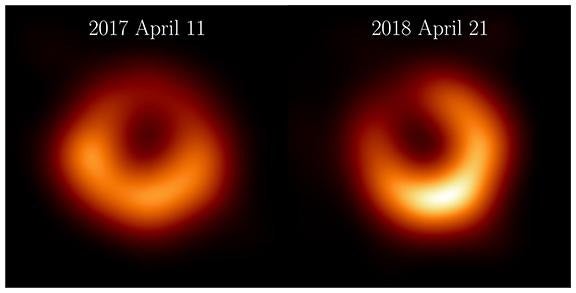
What do you get for staring into the abyss of a black hole for year? Insights into the fundamental workings of gravity.
In 2019, the Event Horizon Telescope (EHT) made headlines with a monumental announcement: the first-ever image of the “shadow” of a black hole. The EHT is really a network of telescopes spanning the entire globe, all working in tandem and giving the network the equivalent resolution of a single dish as wide as our planet. The EHT needed that impressive resolution to capture its first target, the black hole sitting in the center of the galaxy M87, almost 54 million light-years away, in April 2017.
Now the team has finished processing another round of data, taken a year later in April 2018 and including a new instrument in the network, the Greenland Telescope.
“The first image of a black hole looked so similar to the mathematical predictions that it almost seemed like a fluke,” said Dominic Chang, a Ph.D. candidate at Harvard University and member of the EHT. “Getting the opportunity to make new tests using new data with a new telescope, and seeing the same structure, is a crucial confirmation of our most significant conclusions.”
The first image generated by the EHT showcased the “shadow,” the hole carved out of background light by the black hole itself. The size of the shadow is connected to the mass and spin of the black hole, two key properties of those mysteries objects. Astronomers expected that over the course of a year, the black hole should not have changed much, and so the shadow should look roughly the same – which is exactly what the new data revealed.
“One of the remarkable properties of a black hole is that its radius is strongly dependent on only one quantity: its mass,” said Dr. Nitika Yadlapalli Yurk, a former graduate student at the Caltech and now a postdoctoral fellow at the Jet Propulsion Laboratory, in a press release. “Since M87* is not accreting material (which would increase its mass) at a rapid rate, general relativity tells us that its radius will remain fairly unchanged over human history. It’s pretty exciting to see that our data confirm this prediction.”
There was one major difference between the two images; however, that difference didn’t come from the black hole itself, but from the ring of material surrounding it, which can change very quickly. The astronomers noted that in the new data, the brightest part of the ring surrounding the black hole shadow shifted by about 30 degrees.
“The biggest change, that the brightness peak shifted around the ring, is actually something we predicted when we published the first results in 2019,” said Dr. Britt Jeter, a postdoctoral fellow at Academia Sinica Institute for Astronomy and Astrophysics in Taiwan. “While general relativity says the ring size should stay pretty fixed, the emission from the turbulent, messy accretion disk around the black hole will cause the brightest part of the ring to wobble around a common center. The amount of wobble we see over time is something we can use to test our theories for the magnetic field and plasma environment around the black hole.”
The image produced by the EHT is combination of general relativity, which describes the gravitational environment around the black hole, and plasma astrophysics, which describes the hot material surrounding it. The turbulent motions of that plasma can cause shifts on very quick timescales.
It’s for exactly this reason that the EHT program isn’t done. While they’re still processing data collected years ago, the collaboration is designing a new generation of networked telescopes, featuring more instruments each with better capabilities. With the new network, the team hopes to capture even higher resolution and more snapshots of the evolution of the disk material.
“The next-generation EHT (ngEHT) program will expand the array by adding new radio dishes across the globe and extending observations over many radio frequencies, with a goal of making the first black hole movies,” said Sheperd Doeleman, leader of the ngEHT and founding director of the EHT. “We will all have front row seats to black hole cinema by the end of this decade.”
The new images will help astronomers dig deeper into the complicated physics surrounding black holes, peering deeply into the nature of the hot plasma and the black hole itself. If there’s a flaw or shortcoming in Einstein’s general theory of relativity, which has remained the uncontested champion of gravity for over a hundred years, that crack should appear there, deep in the heart of the abyss.









